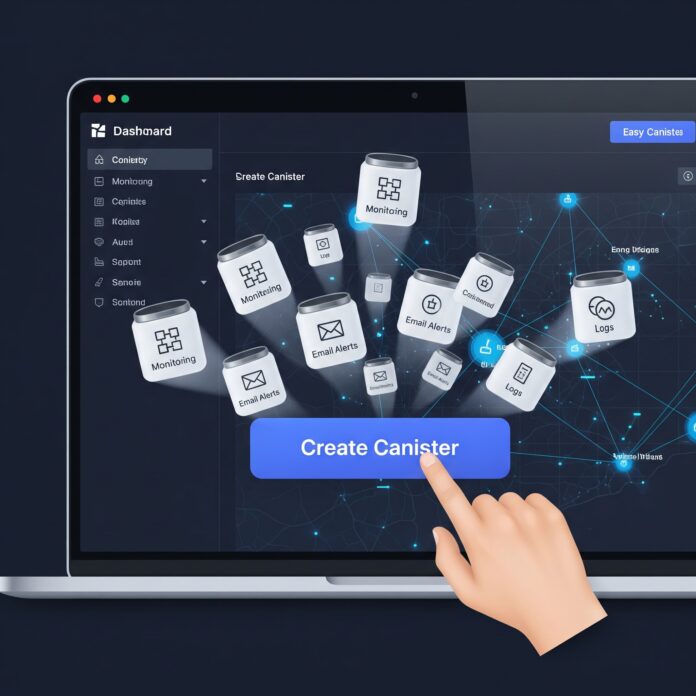Starting a new application on the Internet Computer used to come with a checklist longer than most shopping trips. Juggling command-line instructions, worrying about running out of cycles, and fumbling through configuration flags made launching a project a needlessly complicated rite of passage. Now, CycleOps has decided it’s time to clear the clutter and offer something sharper, simpler and straight to the point—click-based canister creation.
With CycleOps’ new feature, developers can create canisters on the Internet Computer with just a few clicks—no cycle wallet drama, no command-line overload. It’s a user-driven approach that allows anyone to spin up canisters in seconds, directly through the browser via cycleops.dev. No hidden hoops. No setup stress.
Whether you’re a developer starting fresh or someone migrating workloads between subnets, there’s now room for flexibility. Pick a subnet close to your existing canisters for improved latency. Choose one with a higher node count if you’re looking for more fault tolerance. Or just go where it’s quiet—lower traffic, higher storage availability. The choice sits neatly in your hands, where it probably should’ve been all along.
The smart design choices go beyond basic deployment. Each canister created through this tool automatically includes built-in cycle monitoring, so you’re not left guessing whether your app is about to run out of fuel. Email alerts let you know when things look shaky, while integrated canister management features—such as snapshot handling and live log viewing—make ongoing maintenance less of a chore.
It’s a shift from infrastructure tedium to infrastructure transparency. And while there’s still complexity under the hood—there always is—the user doesn’t have to face it head-on. Developers can stay focused on building features rather than battling scripts. This means fewer distractions and quicker delivery cycles.
CycleOps saw the pain points firsthand. The team knew the existing dfx canister create command required users to wade through too many optional arguments and memorise arcane flags. If you were lucky, your cycle wallet had enough juice to push through a deployment. If not, you were backtracking to top up, reconfiguring permissions, and then trying again. The workflow, although powerful, had too many breaking points.

The CycleOps update trims that back significantly. Everything is visual. Want to deploy to a specific subnet? There’s a dropdown menu. Need to check current cycle levels or set up notifications? Done automatically. The fiddly bits are pre-configured or surfaced only when necessary. By stripping away the friction, the team has made canister creation less of a mental tax and more of a productive springboard.
This is particularly helpful when launching dapps that require quick iteration. Canisters, in the Internet Computer architecture, act like the back-end building blocks of decentralised applications. Each one runs in a secure sandboxed environment, and deploying several in tandem is often necessary for anything beyond the most basic projects. The simpler the deployment, the quicker developers can test, tweak, and move forward.
It’s not just for newcomers, either. Even experienced builders can appreciate skipping the manual cycle wallet shuffle or avoiding surprises when cycle levels drop unexpectedly. That extra layer of automation takes the edge off common pain points, especially during tight development windows or rapid scaling.
There’s also an appeal for teams and enterprises experimenting with decentralised services. Often, they want to prototype quickly, test under different subnet conditions, and track canister performance from a high-level dashboard. CycleOps now serves that use case directly, with monitoring and email alerts baked in. It takes a part of the stack that used to be fiddly and patchwork and makes it feel cohesive.
The goal wasn’t to reinvent deployment, just to make it tolerable. What’s been built here is an answer to developer fatigue, especially for those who are more focused on creating value than on deciphering terminal output. It’s a lighter touch for a heavy-duty backend process.
One of the smart design decisions was to keep advanced controls available—but tucked away. Users can still explore different configuration options if they want to optimise further. Maybe they care about data locality. Maybe they want redundancy. Or maybe they’re chasing a subnet with low cost-per-byte for budgetary reasons. All of that can still be explored, without being forced on users from the start.
The result is a smoother onboarding curve, fewer errors caused by manual steps, and a quicker path to ‘hello world’. And once the canister is live, you don’t need to swap back to a separate monitoring dashboard or wait for something to go wrong before investigating. Live logs are visible. Snapshots are manageable. If something breaks, you can actually see what happened—when it happened.
There’s a certain satisfaction in clicking a few buttons and having something just work. That sense of ease is rare in backend infrastructure, especially in Web3. It’s not every day that deployment processes are trimmed back without sacrificing core functionality. But CycleOps seems to have pulled it off by zeroing in on one of the most consistent points of frustration and applying a genuinely helpful interface over it.
Rather than chasing buzzwords or promising a developer utopia, the new feature focuses on reducing friction and providing control without complexity. The changes are practical, not performative. They make things a bit easier without getting in the way.
What comes next is likely to depend on user feedback. CycleOps has already hinted at expanding this visual-first approach to other infrastructure tools in the ICP ecosystem. If this current rollout is anything to go by, it might not be long before more command-line headaches are given the same click-based treatment.
For now, though, creating a canister on the Internet Computer no longer feels like a task that requires a deep breath and a command reference. It’s a few clicks, some light choices, and a working result. The idea that developers need to jump through ten steps just to get started is quietly being retired.
CycleOps has lowered the entry barrier. Developers can get on with building what they want without being sidetracked by setup rituals. And that, more than any marketing language or press splash, might be the best endorsement a tool can earn. A click to create, and you’re off.
Dear Reader,
Ledger Life is an independent platform dedicated to covering the Internet Computer (ICP) ecosystem and beyond. We focus on real stories, builder updates, project launches, and the quiet innovations that often get missed.
We’re not backed by sponsors. We rely on readers like you.
If you find value in what we publish—whether it’s deep dives into dApps, explainers on decentralised tech, or just keeping track of what’s moving in Web3—please consider making a donation. It helps us cover costs, stay consistent, and remain truly independent.
Your support goes a long way.
🧠 ICP Principal: ins6i-d53ug-zxmgh-qvum3-r3pvl-ufcvu-bdyon-ovzdy-d26k3-lgq2v-3qe
🧾 ICP Address: f8deb966878f8b83204b251d5d799e0345ea72b8e62e8cf9da8d8830e1b3b05f
🪙 BTC Wallet: bc1pp5kuez9r2atdmrp4jmu6fxersny4uhnaxyrxau4dg7365je8sy2q9zff6p
Every contribution helps keep the lights on, the stories flowing, and the crypto clutter out.
Thank you for reading, sharing, and being part of this experiment in decentralised media.
—Team Ledger Life


